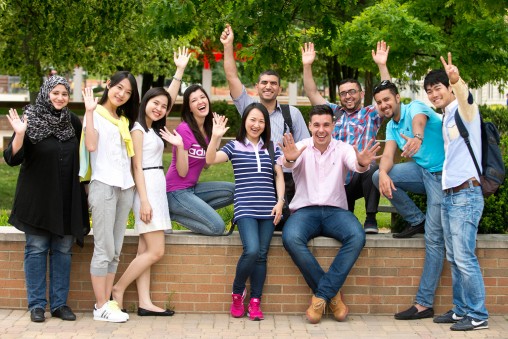 Joining universities across Ohio and the country grappling with domestic population shifts adversely affecting their typical student enrollment populations, Wright State University has embarked on a number of key initiatives to increase enrollments that target international students, scholarship recipients, Indiana students who live near Ohio and even high school sophomores.
Joining universities across Ohio and the country grappling with domestic population shifts adversely affecting their typical student enrollment populations, Wright State University has embarked on a number of key initiatives to increase enrollments that target international students, scholarship recipients, Indiana students who live near Ohio and even high school sophomores.
“Wright State is a fantastic choice for students from all backgrounds,” said Mary Ellen Ashley, vice president for enrollment management. “We must do everything we can to get our best messages and information to students considering us and even those who don’t know us well yet but we could be a great fit for.”
The number of students choosing Wright State has shrunk in the last five years.
From fall 2012 to fall 2017, total headcount enrollment at Wright State declined by 3.8 percent. Recent enrollment declines have included sharp drops in international students, who pay higher tuition than domestic students.
Wright State is taking innovative approaches to develop new enrollment strategies to target students who may not be aware of the high-quality education that Wright State has to offer, all the while continuing to serve the local areas that have been a traditional home of its student body.

That change in approach involves numerous new enrollment initiatives either being implemented considered by Wright State. And it is part of an effort to find the most efficient, effective strategy to capture a shrinking high school population while maximizing the number of undergraduates as well as graduate, international, nontraditional and transfer students.
Here are a few examples of the initiatives:
- Stepped up the marketing of Wright State’s reciprocity agreements with 16 Indiana counties just across the Ohio state line. The agreements offer eligible Indiana students the same lower tuition paid by Ohio residents.
- Launched a new communication campaign to recruit high school sophomores, many of whom are making their college decisions earlier than in the past.
- Implemented the Common Application to increase visibility for prospective students whose high schools encourage using it. The Common App will make it easier to apply to Wright State and potentially generate more applicants.
- Added state and college competitor matches to the college discovery programs of Naviance and Carnegie Dartlett. These programs are used by 67 percent of Ohio high schools and a majority of high schools across the country.
- Launched parent communication plans to help parents of admitted students understand the admission and financial aid processes.
- Increased communications throughout the admission cycle using the new Marketing Cloud capability.
- Planned special visit opportunities for high school students to add an athletic field tour option, on-campus special visits to each college of interest and additional honors visit options — all to happen monthly.
- Launched the new “Last Call for Fall” degree completion marketing campaign in July, targeting students ages 20 to 45 with some college or an associate degree in eight local counties. The multi-channel campaign uses email, direct mail, social media and other digital advertising.
- Implemented a Transfer Peer Mentor program with support of the Wright State Foundation. Through it, transfer students at Wright State connect with incoming transfer students to help them successfully transition to Wright State to improve recruitment and retention.
- Developed a robust social media and communication campaign to market recruitment events at Sinclair College. Twitter campaigns had a 400 percent increase in interaction and reached over 4,000 people.
- Provided training for Sinclair academic advisors to ensure that they were knowledgeable about Wright State academic programs, the benefits of the Wright Path Partnership Program and how to assist students in transferring to Wright State.
- Initiated group campus tour and presentation opportunities for all community college partners.
- Completed a streamlined merit and need-based financial aid strategy to help enroll and retain new direct from high school students and transfer students.
- Increased Wright State’s presence in high schools for financial aid night presentations.
- Built advertising campaigns for Raider Open House, college fair guides across the state and major high school sporting events, and added the university brand to the Beavercreek Golf Club scorecard.
- Implemented email, direct mail and telephone campaigns to new students eligible for the Guaranteed Tuition Program.
- Also implemented email, direct mail and telephone campaigns to all continuing students to advise them of bill due date changes and the consequences of not paying by the due date. This is an effort to help continuing students avoid cancellations for nonpayment.
An additional new effort includes plans to expand and diversify international recruiting instead of focusing on only one or two countries. And the recruiting efforts will be customized for each targeted country.
“In recent years the university became too dependent on just a couple of countries when recruiting international students,” said Bill Holmes, associate vice president for international education. “That made the university too susceptible to factors outside of its control in those countries or other international factors. We have to diversify better, and we are working on that.”

International recruiting for Wright State will be fully outsourced beginning in August 2018 with a focus on two methods:
- Agent network expansion into Morocco, the Baltic countries and Central Asia.
- Full-time boots-on-the-ground recruiters as a part of new investment initiatives. Wright State is currently in negotiations with two international education consultancies that will manage full-time Wright State recruiting personnel across India, the Middle East, North Africa as well as Central Asia.
By partnering with two companies for international recruiting, Wright State should be in a position to leverage decades of international recruiting experience.
The International Admissions and Immigration units of the University Center for International Education have also begun implementing the SUNAPSIS software program that will increase the efficiency in processing international students.
Still, international recruiting is expected to remain challenging as the dollar strengthens and competition for students grows worldwide. The university expects that by increasing Wright State’s physical presence at major recruiting fairs across a variety of countries, it will establish the Wright State’s brand and learn where its niche markets lie. The ultimate goal is to begin ensuring sustainable inflows of students from a variety of countries, creating a more balanced and stable portfolio.
Enrollment Management offices continue admissions presentations and tours, application processing, direct mail and telephone campaigns to follow up with admitted students all summer long to get them registered for orientation and to help them complete all processes for a smooth start in the fall.
Advisors across campus contact all continuing students in good standing to get them registered before they are closed out of their desired class schedules. To all of the standard workload, new initiatives are added every year to reach more admitted students and to more effectively target segments that might produce growth.
Students and families interested in learning more about Wright State and its academic programs should go to wright.edu/visit.

 Celebrated Wright State alum serving his community as surgeon
Celebrated Wright State alum serving his community as surgeon  Wright State University Foundation awards Students First Fund grants
Wright State University Foundation awards Students First Fund grants  Cosmic collection
Cosmic collection  Wright State revives student-faculty collaborative writing journal
Wright State revives student-faculty collaborative writing journal  Fulfilling dreams
Fulfilling dreams 